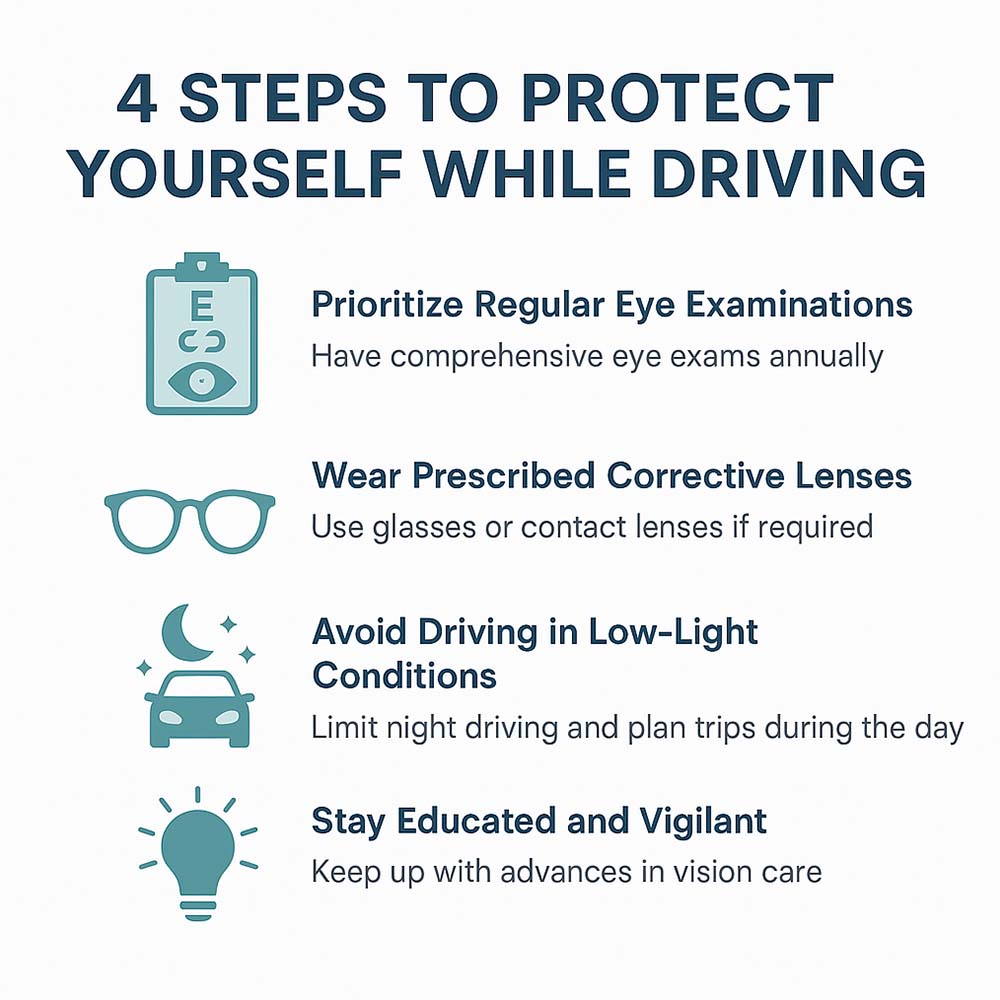
Introduction
Driving is not merely a convenience—it is a responsibility that demands full sensory awareness, with vision playing the most dominant role. Yet, this critical function is often overlooked. The truth is stark: impaired vision is a hidden hazard on our roads, quietly increasing the chances of crashes, injuries, and fatalities.
If left unaddressed, poor vision endangers not only the driver but also passengers, pedestrians, and other motorists. This discussion sheds light on how compromised vision undermines safe driving and explores essential steps to prevent avoidable tragedies through vigilant eye care and timely intervention.
The Dangers of Driving with Poor Vision
Clear, accurate vision is not optional—it is fundamental for making informed, split-second decisions on the road. Drivers with visual impairments are statistically more likely to misjudge, react too slowly, or completely overlook hazards. Here’s how deteriorating vision puts everyone at risk:
Reduced Visual Clarity: Whether due to uncorrected refractive errors, cataracts, or progressive diseases like glaucoma, blurry or distorted vision can prevent a driver from reading road signs, identifying hazards, or spotting pedestrians in time. The inability to see clearly can turn an ordinary trip into a catastrophe.
Faulty Depth Perception: Judging distance is critical for safe overtaking, lane changes, and turning. Impaired depth perception can cause drivers to miscalculate gaps or the speed of oncoming traffic—mistakes that can lead to fatal collisions.
Night Vision Deficiencies: Poor night vision or difficulty adapting to darkness (common in aging eyes or specific conditions) severely limits visibility in low-light environments. This increases the likelihood of missing roadside warnings, pedestrians, or cyclists—especially on dimly lit roads.
Delayed Reaction Times: The ability to process visual information quickly and react accordingly is essential in unpredictable traffic scenarios. Drivers with compromised sight may fail to respond swiftly to sudden braking, swerving vehicles, or changing traffic signals—critical moments where seconds count.

Taking Action: Protecting Lives Through Vision Care
Addressing vision-related driving risks is not only a personal responsibility—it’s a public safety imperative. Here's how drivers can actively protect themselves and others:
Prioritize Regular Eye Examinations: Comprehensive eye exams should be scheduled annually, or more frequently if advised. Conditions like cataracts or macular degeneration often develop gradually, and without routine monitoring, drivers may remain unaware of their declining vision until it’s too late.
Wear Prescribed Corrective Lenses: If glasses or contact lenses have been prescribed, they must be worn without exception while driving. Ignoring this guidance not only compromises safety but may also violate legal driving requirements.
Avoid Driving in Low-Light Conditions: If you experience glare, halo effects, or poor adaptation at night, avoid driving after dark. Plan trips during daylight or arrange alternative transportation. Remember, a single missed hazard in the dark can have irreversible consequences.
Stay Educated and Vigilant: Advances in vision care—from anti-glare coatings to enhanced lenses for driving—are continually evolving. Stay informed and proactive. Recognize that safeguarding your vision is not just about comfort; it's about survival.
Conclusion: Vision Loss Is Silent—But Its Consequences Can Be Sudden
The effects of poor vision on driving are not abstract—they are deadly real. Accidents, injuries, and loss of life are often the result of preventable visual deficiencies. By committing to regular eye care and taking corrective action early, drivers can reduce risks, protect others, and maintain their independence on the road.
Don’t let declining vision become the reason for a preventable tragedy. Your eyes are your steering wheel—keep them in focus.
← Back to Blogs




Mark Smith
Jan 28, 2016 - 10:07 pmLorem ipsum dolor sit amet, consectetur adipisicing elit, sed do eiusmod tempor incididunt ut labore et dolore magna.
replySteve Martin
Jan 28, 2016 - 10:07 pmLorem ipsum dolor sit amet, consectetur adipisicing elit, sed do eiusmod tempor incididunt ut labore et dolore magna.
replyMark Smith
Jan 28, 2016 - 10:30 pmLorem ipsum dolor sit amet, consectetur adipisicing elit, sed do eiusmod tempor incididunt ut labore et dolore magna.
replyMaya Jonson
Jan 28, 2016 - 08:07 pmLorem ipsum dolor sit amet, consectetur adipisicing elit, sed do eiusmod tempor incididunt ut labore et dolore magna.
replySteve Martin
Jan 28, 2016 - 10:30 pmLorem ipsum dolor sit amet, consectetur adipisicing elit, sed do eiusmod tempor incididunt ut labore et dolore magna.
reply